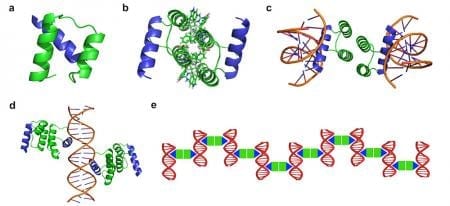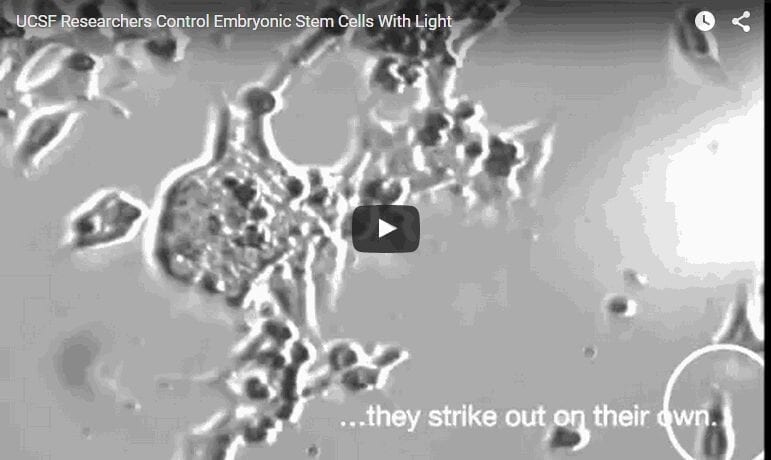
The ability to custom design biological materials such as protein and DNA opens up technological possibilities that were unimaginable just a few decades ago. For example, synthetic structures made of DNA could one day be used to deliver cancer drugs directly to tumor cells, and customized proteins could be designed to specifically attack a certain kind of virus.
Although researchers have already made such structures out of DNA or protein alone, a Caltech team recently created—for the first time—a synthetic structure made of both protein and DNA. Combining the two molecule types into one biomaterial opens the door to numerous applications.
A paper describing the so-called hybridized, or multiple component, materials appears in the September 2 issue of the journal Nature.
There are many advantages to multiple component materials, says Yun (Kurt) Mou (PhD ’15), first author of the Nature study. “If your material is made up of several different kinds of components, it can have more functionality. For example, protein is very versatile; it can be used for many things, such as protein–protein interactions or as an enzyme to speed up a reaction. And DNA is easily programmed into nanostructures of a variety of sizes and shapes.”
But how do you begin to create something like a protein–DNA nanowire—a material that no one has seen before?
Mou and his colleagues in the laboratory of Stephen Mayo, Bren Professor of Biology and Chemistry and the William K. Bowes Jr. Leadership Chair of Caltech’s Division of Biology and Biological Engineering, began with a computer program to design the type of protein and DNA that would work best as part of their hybrid material. “Materials can be formed using just a trial-and-error method of combining things to see what results, but it’s better and more efficient if you can first predict what the structure is like and then design a protein to form that kind of material,” he says.
The researchers entered the properties of the protein–DNA nanowire they wanted into a computer program developed in the lab; the program then generated a sequence of amino acids (protein building blocks) and nitrogenous bases (DNA building blocks) that would produce the desired material.
However, successfully making a hybrid material is not as simple as just plugging some properties into a computer program, Mou says. Although the computer model provides a sequence, the researcher must thoroughly check the model to be sure that the sequence produced makes sense; if not, the researcher must provide the computer with information that can be used to correct the model. “So in the end, you choose the sequence that you and the computer both agree on. Then, you can physically mix the prescribed amino acids and DNA bases to form the nanowire.”
The resulting sequence was an artificial version of a protein–DNA coupling that occurs in nature. In the initial stage of gene expression, called transcription, a sequence of DNA is first converted into RNA. To pull in the enzyme that actually transcribes the DNA into RNA, proteins called transcription factors must first bind certain regions of the DNA sequence called protein-binding domains.
Using the computer program, the researchers engineered a sequence of DNA that contained many of these protein-binding domains at regular intervals. They then selected the transcription factor that naturally binds to this particular protein-binding site—the transcription factor called Engrailed from the fruit fly Drosophila. However, in nature, Engrailed only attaches itself to the protein-binding site on the DNA. To create a long nanowire made of a continuous strand of protein attached to a continuous strand of DNA, the researchers had to modify the transcription factor to include a site that would allow Engrailed also to bind to the next protein in line.
“Essentially, it’s like giving this protein two hands instead of just one,” Mou explains. “The hand that holds the DNA is easy because it is provided by nature, but the other hand needs to be added there to hold onto another protein.”
Another unique attribute of this new protein–DNA nanowire is that it employs coassembly—meaning that the material will not form until both the protein components and the DNA components have been added to the solution. Although materials previously could be made out of DNA with protein added later, the use of coassembly to make the hybrid material was a first.
This attribute is important for the material’s future use in medicine or industry, Mou says, as the two sets of components can be provided separately and then combined to make the nanowire whenever and wherever it is needed.
Read more: Making Nanowires from Protein and DNA
The Latest on: Protein and DNA Nanowires
[google_news title=”” keyword=”Protein and DNA Nanowires” num_posts=”10″ blurb_length=”0″ show_thumb=”left”]
via Google News
The Latest on: Protein and DNA Nanowires
- Marriage of synthetic biology and 3D printing produces programmable living materialson May 1, 2024 at 6:42 am
Scientists are harnessing cells to make new types of materials that can grow, repair themselves and even respond to their environment. These solid "engineered living materials" are made by embedding ...
- SARS vaccines: where are we?on April 30, 2024 at 5:00 pm
We discuss inactivated vaccines, virally and bacterially vectored vaccines, recombinant protein and DNA vaccines, as well as the use of attenuated vaccines. Data regarding the correlates of ...
- Bacteria 'nanowires' could help develop green electronicson April 29, 2024 at 7:30 am
Engineered protein filaments originally produced by bacteria have been modified by scientists to conduct electricity. In a study published recently in the journal Small, researchers revealed that ...
- AI-designed gene editing tools successfully modify human DNAon April 24, 2024 at 5:51 am
Medically, AI is helping us with everything from identifying abnormal heart rhythms before they happen to spotting skin cancer. But do we really need it to get involved with our genome? Protein-design ...
- Polycomb repressor proteins get trapped in a web of HSATII DNA upon DUX4 activation, leading to DNA damageon April 16, 2024 at 5:01 pm
Most of our genome is often written off as “junk DNA”, meaning it doesn’t encode for genes that get made into proteins. This so-called junk consists of accumulated DNA elements like viral DNA that got ...
- DNA: The hidden dangers of protein powderson April 15, 2024 at 5:00 pm
Zee News DNA: The hidden dangers of protein powders Posted: April 16, 2024 | Last updated: April 16, 2024 Nowadays, most of the people going to the gym take protein supplements. It is claimed that ...
- A freak DNA change 25 million years ago is why humans lack tailson April 9, 2024 at 4:00 am
Every cell of an organism contains a full copy of that organism’s DNA, called the genome. The genome contains the information that the cell uses to make proteins, the workhorses of the cell.
- UMich researchers use machine learning to predict properties of proteins to improve protein optimizationon April 4, 2024 at 5:00 pm
Case said that future research could leverage more powerful artificial intelligence models to get a better understanding of the complex relationships within protein and DNA sequences, just as large ...
- Biotechnology and Bioengineering Newson February 12, 2024 at 4:00 pm
Apr. 23, 2024 — Researchers describe the steps they took to manipulate DNA and proteins -- essential building blocks of life -- to create cells that look and act like cells from the body.
- Structure and function of deoxyribonucleic acid (DNA)on August 22, 2022 at 4:00 am
The information DNA contains is the instructions that the cell uses to make proteins. Proteins play a big part in determining the characteristics of specialised cells and whole organisms.
via Bing News










